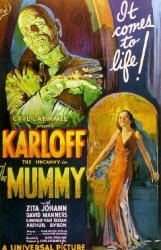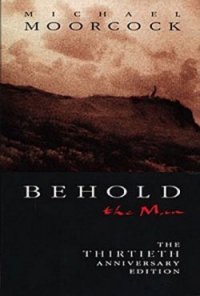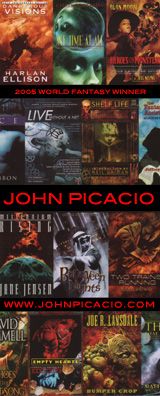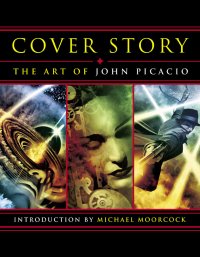1. When did you first become aware of fantasy or horror art?
 Well, if superhero comics are considered fantasy, then those would certainly be my first connections to the field. Superman
and Batman comics were the first things that I can remember grabbing my attention. Especially Batman. But as far as
more pure strains of fantasy and horror art, I'd have to say the old Universal horror films from the 1930s, and the posters
Well, if superhero comics are considered fantasy, then those would certainly be my first connections to the field. Superman
and Batman comics were the first things that I can remember grabbing my attention. Especially Batman. But as far as
more pure strains of fantasy and horror art, I'd have to say the old Universal horror films from the 1930s, and the posters
 connected to them, hit me pretty early on. When I was a kid, I used to watch this TV programme on Saturday afternoons with
my mother called "Screaming Meemies" and they would re-broadcast the old Universal films. I loved the look of those
films, and I especially loved the movie posters for those films.
connected to them, hit me pretty early on. When I was a kid, I used to watch this TV programme on Saturday afternoons with
my mother called "Screaming Meemies" and they would re-broadcast the old Universal films. I loved the look of those
films, and I especially loved the movie posters for those films.
2. What made you want to become an artist?
I don't know. It was always there. I can't remember when it wasn't there. I've always had a very visual memory and love of drawing and making pictures. I've always had very vivid dreams as well, and I think that stuff finds its way into my problem-solving for illustrations.
The high school pressure to work toward a professional degree led me to go to architecture school, instead of art school, but as you can see, you can't escape that which you are. I graduated with a degree in architecture, but I'm no longer pursuing architecture. I'm doing what I love most, which is drawing and painting pictures. I'm grateful for architecture school, and I'm not sure that I'd be where I am now without the rigors of design training. I learned a lot about design process and critical thinking in architecture school, and it was a pretty ruthless and competitive atmosphere. I think I'm endlessly better for that experience. I use a lot of those same skills when I'm illustrating and designing covers for fantasy, horror and science fiction covers.
3. Who are your major influences and why?
As far as the "whos", we could go a long time. As far as the "whys", I guess because I feel like I'm influenced by everything I see, in some way or another. I really do feel that the world can be your palette, and I don't really feel limited by one particular medium or style.
In fact, I think when I hear that a creator adheres to a certain "style" in terms of a creative approach, I'm immediately suspicious. I think styles are ultimately limiting. They keep you from seeing the big picture and they often celebrate surface and agenda over substance and problem-solving. I'm interested in folks who are taking what's come before and advancing it a little further. I like good questions more than answers. I'm interested in creators who offer a little slice of themselves in everything that they do.
So with that in mind, I would say some of my major influences (in no particular order) would be Gustav Klimt, Jorge Luis Borges, Kurt Schwitters, Joseph Campbell, Andrey Tarkovsky, Joseph Cornell, Marcos Novak, Dave McKean, Kent Williams, George Pratt, Jon Muth, Robert Rauschenberg, Chip Kidd, Barron Storey, Kathe Kollwitz, Jeff Jones, Bill Sienkiewicz, Bob Peak, N.C. Wyeth, Pablo Picasso, Howard Pyle, Salvador Dali, Marshall Arisman, Vincent DiFate, J.K. Potter . . . those are a few off the top of my head.
4. How difficult was it for you to initially get your work noticed?
 I self-published a comic book called Words & Pictures back in the mid-1990s along with my buddy Fernando Ramirez. I did the covers on these comics, and those covers led Mojo Press to offer me a job illustrating and designing the cover for the 30th Anniversary Edition of Michael Moorcock's Behold the Man in 1996. So I guess the book business kinda came and found me.
I self-published a comic book called Words & Pictures back in the mid-1990s along with my buddy Fernando Ramirez. I did the covers on these comics, and those covers led Mojo Press to offer me a job illustrating and designing the cover for the 30th Anniversary Edition of Michael Moorcock's Behold the Man in 1996. So I guess the book business kinda came and found me.
That job changed my life because I've had the bug to do book covers ever since. Over the next five years after that, it was a steady process of me working my day job in architecture and trying to build a clientele for my cover work in my off-hours. It meant a lot of cold calls, a lot of rejection, and a lot of trips to New York and San Francisco . . . just trying to let art directors know that I was out here. But I loved the work, and I wanted to work in this business so badly, so I stayed after it.
I went to the World Fantasy Convention in 2000, put up some of my work in the Art Show and took a portfolio of my work to show around. That was my first pro convention, and I think that's when I started to show up on people's radar. I won one of the "Best of Show" prizes in the Art Show, Ed Bryant mentioned me as one of the highlights of that show in Locus magazine, and I made a lot of friends in the industry that weekend.
Things have slowly and steadily escalated from there. I left architecture for good in 2001, and I've never looked back. I've been full-time doing covers for horror, fantasy and science fiction ever since. It's an on-going process though. It never ends. You either stay relevant or fade away, and that suits me just fine.
5. What do awards mean to you?
| Advertisement |

|
| Click on Image |
They mean a lot to me. They really do. I cherish the ones that I've received and I appreciate them so much. I'm very grateful any time that I'm in consideration for one. There's a flip side, though, that I try to keep in mind.
When you look at the history of awards in any field, they don't necessarily recognise the vanguard of a given medium, and I think that's the place where I ultimately want to be. Step back and look at a guy like Vincent Van Gogh. A visionary painter who was way ahead of his time, but he died penniless and relatively devoid of recognition in his lifetime. His work stands the test of time and expanded the range of human experience, but he certainly didn't receive any awards and audience recognition in his lifetime.
Look at what happened when Pablo Picasso first unveiled 'Les Demoiselles d'Avignon' to the Paris art scene in 1907. His peers, his patrons and critics worldwide threw him to the dogs and said he was out of his mind. They said the piece was worthless garbage. But in reality, that painting signaled the dawn of a new era, and it forever expanded the way the world thinks and sees. Picasso was so ahead of his time, but the rest of the world wasn't ready. They were ready to lynch him, not pin medals to his chest. Today that painting is widely recognised as one of the most important pieces of artwork on the planet in the last 100 years.
So I think to truly be an artist, you've got to be out there expanding the range of human experience, and that's a very heavy thing to attempt, with potentially heavy personal costs. History has shown that it often means that you're not necessarily going be embraced in your own time, while doing it.
I'm certainly not saying I want to die penniless or need to be a martyr to be a great artist, but I do believe that awards don't necessarily herald the apex of an artist's true service to his audience, or himself for that matter.
So I guess what I'm saying is that awards are terrific and I love 'em, but I don't think they mean that I can rest easy, and my job is done. In many ways, I think they mean: "Good start. Now get on with the real work of being an artist".
6. Do you find the process of creating an illustration difficult?
Sure. Especially when you're trying to push yourself toward places you've never gone before, or where your audience hasn't gone before for that matter. But I really believe that if you don't enjoy that challenge and that adversity, then you're not really a creator. That's part of the joy of this whole thing.
7. You use a number of techniques to create a work. Can you describe them?
I guess, in a nutshell, I would say that I like tension between media, and I like texture. I like drawing and painting and everything starts with those loves and everything builds on that foundation. If you look across the range of my work, you'll see some collage, some assemblage – both real-world and digital, some shadowboxes, found objects, some occasional photography in my earlier work . . . it's a really mixed bag.
Anything is valid as a communication device, in the proper context. But it's funny that the further I go along, the more I've become dedicated to just being a better draftsman and a better painter, and everything else is secondary.
In general, a lot of my recent work is drawings and paintings that are scanned into the computer and then digitally merged to capitalise on all of their strengths and juxtapositions. The nice thing about combining them in the digital world is the element of surprise when something juxtaposes with something else in a way I never expected. And then it's a matter of how I can capitalise on that opportunity.
It's all very intuitive, but that's fun stuff. I'm pretty traditional though in terms of drawing and painting in that I don't draw and paint via computers, but I only use digital media to augment things I do in the real world. The reason is that I like to get my hands dirty every day and, if I did everything via the digital world, it wouldn't be enjoyable to me.
8. What are your professional goals, or have you already achieved them?
No, I certainly haven't achieved them yet. I feel like I just got started really.
 I love diversity and I respect guys that have a range of diversity in their work, so I'm proud that I've been able to carve out a little niche simultaneously in the fields of horror, fantasy and science fiction. They're all very different, and I've loved all three since I was a kid. It's a real privilege to be a part of all of them at the same time, and I don't see a lot of illustrators today who can do that, quite frankly.
I love diversity and I respect guys that have a range of diversity in their work, so I'm proud that I've been able to carve out a little niche simultaneously in the fields of horror, fantasy and science fiction. They're all very different, and I've loved all three since I was a kid. It's a real privilege to be a part of all of them at the same time, and I don't see a lot of illustrators today who can do that, quite frankly.
So trying to stay relevant in each of those fields, and bringing something new to the table every year, is certainly important to me. Besides the obvious goal of just wanting to be better at my craft, I'd say that I'd like to keep expanding the range of my work.
I'd like to do some children's book illustration. I'd like to do more covers for the YA market. I wouldn't mind doing some movie poster work someday and being part of a movement to bring movie posters back to being interesting, illustrated things. I'd like to do a cover for Time magazine someday. I'd like to have one of my illustrations ten stories tall hanging off a building in Times Square someday. All right . . . I think that's enough.
In all seriousness, I just achieved one of my major goals – which is I always wanted to have a book of my work out there. In May 2006, MonkeyBrain Books will be releasing a 200-page hardcover called Cover Story: The Art of John Picacio, and it'll feature a lot of my covers from the last several years, along with sketches and ideas about the process of making the cover illustrations. It's at the printer right now, as I type this, and I'm really proud of it.
9. What advice would you give to any genre artists just starting out?
I guess I'd tell them what my father told me way back when. Figure out what you love the most and then go be the best in the world at it. Pretty corny, but true.
I'm certainly not saying that I'm the best in the world by any stretch, but I am doing what I love the most right now, and that's illustrating covers for all of these great books.
I'd tell folks that are starting out to use the convention scene to their advantage. For example, if they want to build a horror audience for their work and that's where their aspirations are, then I can really think of no better place to be than the World Horror Convention. Same goes for science fiction via the World Science Fiction Convention or fantasy via the World Fantasy Convention. I think even if you're just starting out, it's a real eye-opener when you start to participate in these shows. You really start to understand the business from all aspects, and not just your own. You get to meet new people and build new relationships. Your ideas and perspectives are challenged. For someone just starting out, shows like the World Horror Convention are incredibly valuable experiences and they can be huge turning points early on.
10. How do you feel about being Artist Guest of Honour at the 2007 World Horror Convention in Toronto?
I couldn't be happier about it. I'm really grateful for the opportunity. I've done Guest of Honour spots before, but this will be my first time being Guest of Honour for a major international convention, and I'm looking forward to being of service to the con and being a part of all the festivities.
I'm looking forward to seeing a lot of my old friends and meeting new ones. I've never been to Toronto, and I've heard nothing but great things about the city. It's even better because Michael Marshall Smith is an Author Guest of Honour at this show, and I've got huge respect for him as an author and he's a tremendous guy as well – so it's going to be huge fun. I can't wait.

